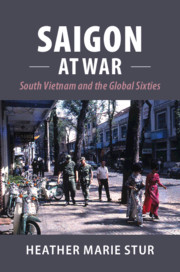Book contents
- Saigon at War
- Cambridge Studies in US Foreign Relations
- Saigon at War
- Copyright page
- Dedication
- Contents
- Figures
- Acknowledgments
- Introduction
- 1 The Heart of South Vietnam
- 2 A Tradition of Activism
- 3 South Vietnam’s Sixties Youth
- 4 South Vietnam and the World
- 5 Building Connections between the People and the Government
- 6 Saigon after Tet
- 7 The Catholic Opposition and Political Repression
- 8 Saigon in the Seventies
- Conclusion
- Select Bibliography
- Index
Conclusion
Published online by Cambridge University Press: 15 May 2020
- Saigon at War
- Cambridge Studies in US Foreign Relations
- Saigon at War
- Copyright page
- Dedication
- Contents
- Figures
- Acknowledgments
- Introduction
- 1 The Heart of South Vietnam
- 2 A Tradition of Activism
- 3 South Vietnam’s Sixties Youth
- 4 South Vietnam and the World
- 5 Building Connections between the People and the Government
- 6 Saigon after Tet
- 7 The Catholic Opposition and Political Repression
- 8 Saigon in the Seventies
- Conclusion
- Select Bibliography
- Index
Summary
When the members of the CBC Band embarked on an eighteen-month world tour in 1973, they did not realize it would be the last time they would ever see the Vietnam that they knew. The band, and the Phan siblings’ lives in Vietnam, were casualties of war. Tung Linh, the guitarist, received his draft notice in 1973, and he entered boot camp for six months of training. But his mother, Hoang Thi Nga, in the role she had played his whole life, did what she could to help her son play music, which was what made him happy. She paid a handsome bribe to a high-ranking officer to secure her son’s release from the army, arguing that she was old and needed him at home, and in any case, two older sons had already served in the navy.1
- Type
- Chapter
- Information
- Saigon at WarSouth Vietnam and the Global Sixties, pp. 260 - 270Publisher: Cambridge University PressPrint publication year: 2020

